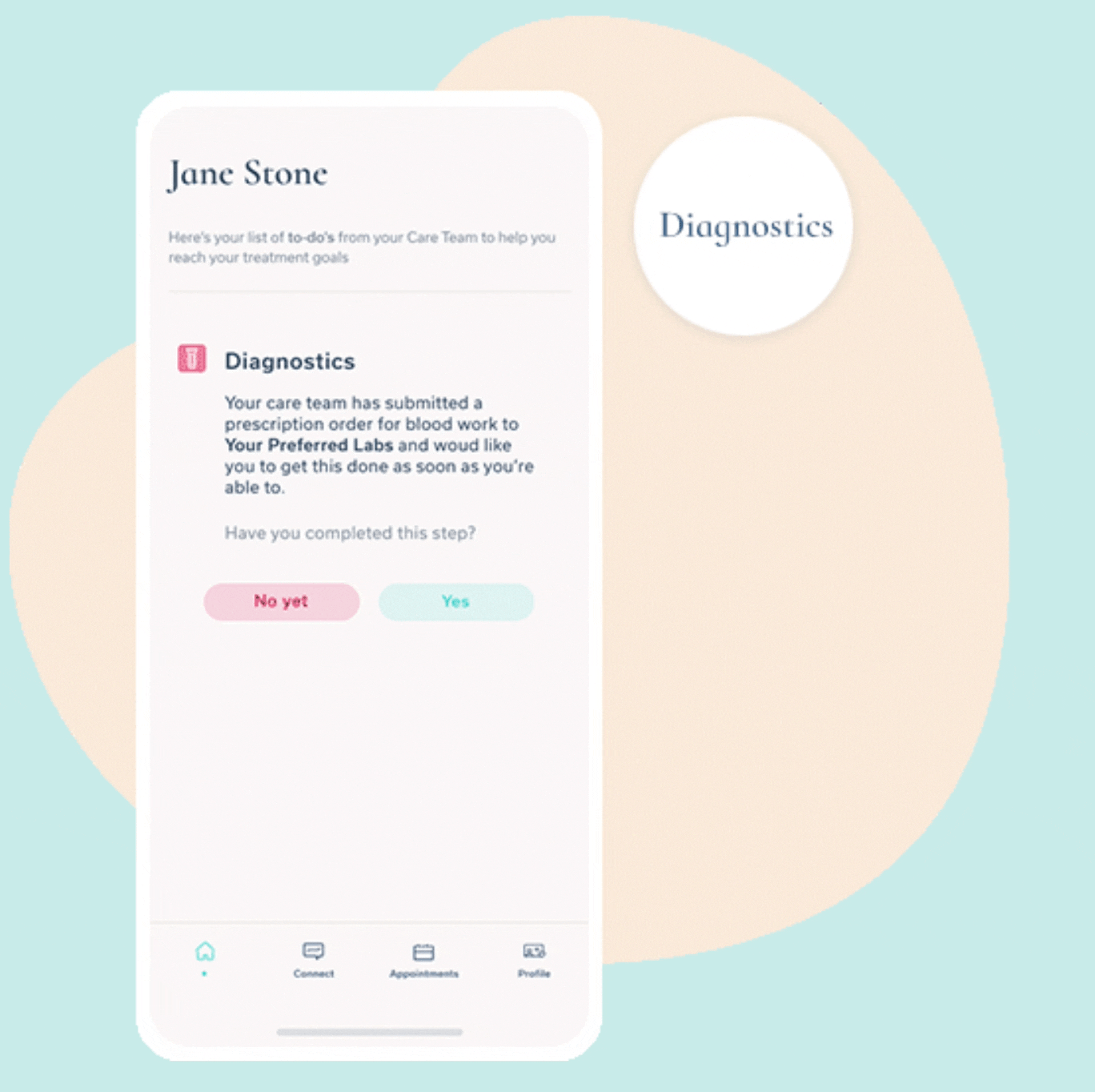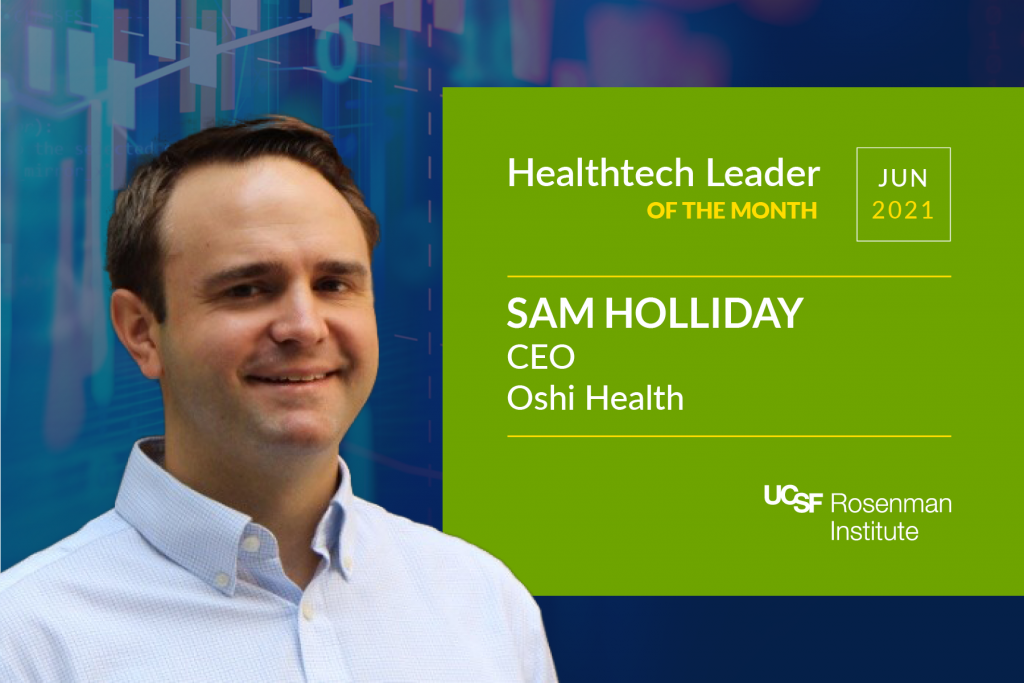For the June installment of the Healthtech Leader of the Month series, we interviewed Sam Holliday, CEO of Oshi Health. Oshi Health is a virtual-first clinic delivering integrated care for gastrointestinal conditions including Irritable Bowel Syndrome (IBS), Inflammatory Bowel Disease (IBD), Gastroesophageal Reflux Disease (GERD), and a range of other conditions.
Oshi Health Reimagines Treatment for GI Conditions
Oshi Health is scaling access to evidence-based treatment for gastrointestinal conditions including IBS and IBD. GI conditions present a silent and significant problem; an estimated 1 in 5 adults suffer with a diagnosed digestive health condition, and many more have chronic undiagnosed symptoms.
“GI conditions are really stigmatized. People aren’t even talking to their friends and family about what they’re feeling and how they’re struggling,” says Oshi Health’s CEO, Sam Holliday. “Integrated GI care is a missing piece of the healthcare infrastructure. There’s a huge group of people who don’t have anywhere to go to get care that’s proven to work.”
Many people living with GI conditions have trouble finding care because many payers, health plans, and employers have yet to realize the scope of the problem. “Because so many people have unfortunately not found help from the traditional healthcare system, they don’t realize that this is something they can get help with,” Sam says. “Helping people understand what this care model can do for them is an integral part of our mission.”
Oshi Health provides whole-person care through a combination of GI specialized care, nutrition, and mental health that is built to be complementary to in-person care. After 10 weeks in the Oshi Health program, 91% of members reported improved symptom control.
Check out their website.

Sam Holliday: 3 Lessons Learned
When Sam Holliday looked for a healthcare technology job in New York in 2009, the only company he could find was WebMD. Instead, he walked into J.P. Morgan as an investment banker and asked to work on all their healthcare technology deals. He spent the next decade advising and then working for multiple health technology companies including Greenway Health, Everyday Health, and Cecelia Health, a telehealth platform for diabetes management.
In 2018, Sam became fascinated by companies like Virta Health, which use food as medicine for diabetes. He was simultaneously hearing from his mom and sister, both of whom were suffering from GI conditions. “I saw this match between my family experiences and the way that Virta approaches helping people with diabetes to reverse the impact of that condition on their daily life. Whole-person care gets people feeling better and saves money for whoever’s paying for care, while also creating this great experience,” he says. “It was all done virtually, it was easy to access, it was technology and data-driven. And as I heard my mom’s and my sister’s stories, it came together: would a Virta model for GI work?” Sam recognized an opportunity to build an integrated care model that uses a combination of medication, food, and psychological intervention to manage GI conditions. Here are a few things Sam has learned on his journey to building Oshi Health.
Lesson #1: Understand how the money flows.
“In healthcare, you really need to understand how the money flows and how that creates incentives for different parties in the healthcare ecosystem. In order to figure out how to build a business, how to get it paid for, you have to understand how the money moves around in the system. The different incentives for the different players are always important, no matter what kind of healthcare business you’re building,” Sam says. Part of Oshi Health’s strategy for reaching payers is emphasizing the pervasiveness of GI conditions and their impact. “GI conditions are high cost and also among the highest drivers of missed work and lost workplace productivity,” says Sam. “We’ve been building that into the story to show how valuable this can be.”
Lesson #2: Be ready for really long sales cycles.
“You have to be ready for really long sales cycles. It’s very relationship-based,” Sam says. “Find people who have been in the space and have built companies or sold solutions into the market, and really learn and leverage those relationships to get in the door and start a conversation.” He emphasizes the importance of starting with the person suffering from a condition in healthcare, but not stopping there. To understand how a solution can fit into the ecosystem, Sam recommends interviewing providers, health plans, employers, benefit consultants, family members, and caregivers as well. “Have an open mind and hear what those people are dealing with, and then figure out how you can create the most value for all of the different parties involved,” he says.
Lesson #3: Make your values your language.
Sam takes leadership inspiration from Beyond Entrepreneurship by Jim Collins and Scaling Up by Verne Harnish. “It starts with defining your core values. The books all say that it comes out of the founder, what their operating system for life is, and what they believe. For us, we started with our leadership team right up front in defining what those were,” Sam says. “The key is to use them. Use them every day in conversation. It becomes your language as a company, both to hold each other accountable, and to reinforce those values. They’re not just on the wall, they’re our language.” One of the ways that Oshi Health incorporates this philosophy into their daily interactions is through their all-hands meetings, which end with people offering shoutouts to their colleagues for demonstrating the company’s core values. Sam says they actively use Jim Collins’ vision framework to help clarify Oshi Health’s core principles: What are your values? What’s your purpose? What’s your mission?
The Right Thing, the Right Care Model: Final Thoughts
“How do you get the right people to know that you exist and then to check you out?” Sam asks. For people with GI conditions, their journey to health often starts at their primary care providers. Oshi Health went and talked to brick-and-mortar primary care providers, and asked what it would take for them to refer patients to Oshi Health. “Can we talk to them about sending people our way if they identify this need?” Sam asks.
Oshi Health’s platform has received overwhelmingly positive feedback from patients. “It’s like the first time people saw color TV. You didn’t know you needed it and wanted it until you saw it, and then you couldn’t imagine watching TV in black and white anymore. And our care model is like that for a lot of people. They just didn’t know they could get this kind of help and support and feel this way until they came to us,” Sam says.
Oshi Health’s main focus now is increasing coverage; their program is currently available in 3 states and expanding to more by early 2022. “The feedback from people that we’re helping is just so consistently positive,” Sam says. “I know we’re doing the right thing to help these people; I know we have the right care model, and now we just need to scale it. We’re just going to keep working hard at that.”
Join Our Vibrant Community.
“I think what’s great about the UCSF Rosenman ADAPT program in particular is that actual buyers were the sponsors. They take it seriously and they work with the companies that they pick, help them prove out their models, and get their programs up and running, and they do it in a robust way.”
Sam Holliday, CEO Oshi Health
You’re not alone in your mission to bring better health technology to patients and medical professionals. Now more than ever, connecting with a global community of entrepreneurs is an invaluable step towards realizing your goals within the health technology world.
Receive invitations to free and paid virtual events with healthtech entrepreneurs, payers, and service providers when you subscribe to our newsletter.
